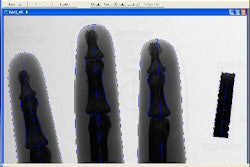Hysterosalpingography remains the imaging technique of choice for visualizing the upper reproductive tract in infertile women, and the addition of contrast agents has enhanced this exam. While complications, including venous-lymphatic intravasation, have been reported because of this pairing, there are still questions as to how serious these risks are. Not serious enough to terminate a hysterosalpingography (HSG) procedure, according to Italian radiologists.
"Intravasation in venous/lymphatic vessels represents a potential condition predisposing to cerebral and/or pulmonary embolism," wrote Dr. Alfred La Fianza and colleagues in the Journal of Women's Imaging. The group is from IRCCS Policlinico San Matteo at the University of Pavia in Pavia, Italy (JWI, March 2005, Vol. 7:1, pp. 38-43).
During this eight-year study, HSG was performed with digital equipment (Angiorex, Toshiba America Medical Systems, Tustin, CA) under fluoroscopy. Three types of contrast media were used: iodinated, hydrosoluble nonionic (Iopamidolo 370, Bracco, Milan, Italy; or Iodixanolo 320, GE Healthcare Bio-Sciences, Chalfont St. Giles, U.K.), or hydroviscous (Iodamide, Bracco). The average amount of contrast given was 6 mL.
Of the 1,395 women, 95% were imaged with nonionic iodinated HSG (320-370 mgI/mL concentration), while only 5.2% underwent hydroviscous HSG. There were 19 cases of intravasation in 14 patients, the majority of which were monolateral venous, followed by bilateral venous and monolateral lymphatic. However, none of these patients presented with pulmonary or cerebral complications, the authors stated.
Seven of the 14 presented with HSG alterations of tubal patency, such as hydrosalpinx and bilateral tubal occlusion. Otherwise, 567 patients with alterations of the uterine/tubal patency did not report intravasation.
"The incidence of venous/lymphatic intravasation during HSG in literature varies from 0% to 6%," the authors wrote. "In our experience, using hydrosoluble nonionic contrast media, we observed an incident of 1.3%.... The observation of intravasation is not an indication to terminate the procedure."
The authors added that they also found an association between intravasation and alterations in the tubal and uterine canalization. This complication most likely occurs in cases of malformation, endometritis, adenomyosis, and altered tubal patency, they concluded.
By Shalmali Pal
AuntMinnie.com staff writer
May 9, 2005
Related Reading
Iodixanol more cost-effective than iohexol in renal angiography, April 15, 2005
Studies bolster sonography's value for abnormal gynecological bleeding, November 5, 2004
Copyright © 2005 AuntMinnie.com



















